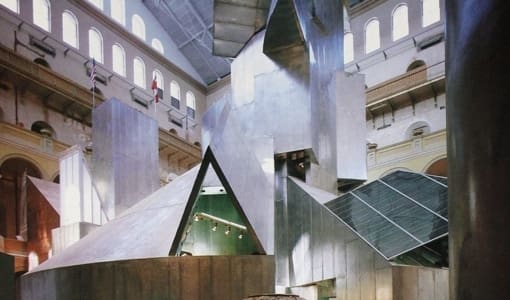Galvanized Steel
*Although we do not offer supply only sheets of galvanized steel, we are happy to custom fabricate based upon your project’s needs. We selectively partner with vendors offering the highest quality materials available in many sizes and thicknesses. Please call for details.
Galvanized steel has a lot more to offer than an industrial appearance. We can darken the coating, and we can create unique iridescence in the surface of galvanized steel, all applied post-fabrication to give you the benefits of galvanized steel with an architectural finish.
There are two predominant types of galvanized steel: hot-dipped galvanized and electroplate galvanized. The hot-dipped process takes a steel surface and dips it in molten pure zinc. Zinc plating or electroplating takes a steel surface and applies a thin coating of zinc using an electric current. Electroplating is a thinner less resilient surface and is not recommended for exterior use or heavily trafficked interior use.
Hot-Dipped Galvanized Steel
Hot-dipped galvanizing uses an immersion technique whereby the steel is dipped in a bath of molten zinc. The duration of immersion in the bath determines the thickness obtained. A metallurgical bond is formed between the zinc surface and the steel.
This bond provides the major difference between electroplating and hot-dipped zinc. Hot-dipping creates an intermediate alloy layer between the highly pure zinc and the steel. This intermediate layer provides a significant amount of the corrosion protection to the steel base material. The outer, pure zinc layer acts as a barrier to protect the steel and gives the metal its characteristic color and spangle appearance. The inner layer provides a transition zone that resists attack on the base steel by sacrificial action.
GALVANIZED STEEL AND STAINLESS STEEL USED ON TOWER PARK SCULPTURES IN CLEVELAND, OHIO
PHOTO © A. ZAHNER COMPANYPHOTO OF HOT-DIPPED GALVANIZED STEEL CUSTOM GUARDRAIL.
PHOTO © TOM KESSLERElectroplated Galvanized Steel
The electroplated galvanized steels have the pure zinc outer layer but lack the intermediate alloy layer that mixes the steel and zinc.
Galvanized surfaces will lose the spangle and form a gray zinc oxide film with a slight tooth or fuzziness to them. Sometimes, streaks of red rust will develop on galvanized steel surfaces where the steel is no longer getting the benefit of the galvanic protection.
Spangle Galvanized Steel
One of the visual effects resulting from galvanization of steels is an appearance of crystalline spangling across the surface. The spangle is a unique and interesting formation on the galvanized surface. It is created by use of trace metals in the molten zinc, and by controlling the cooling process of the hot-dip zinc coating on the steel.
The process involves running a sheet, plate, structural shape, or constructed shape into a molten bath of high-purity zinc. Additional trace metals are put into the molten zinc to assist in the formation of the zinc crystal on the surface. As the hot, coated steel exits the bath of zinc, it is blasted with air to remove excess zinc from the surface. The zinc surface cools with the steel base material. As the surface cools, crystals of zinc develop across the surface.
Spangled Galvanized Steel: Environmental Concerns
Large spangles can be achieved on galvanized sheet, but it comes at a cost: these materials often contain lead content. There are other methods to create spangle on galvanized materials, including the use of Antimony, a lustrous grey metalloid for alloying metals. However, Antimony-alloyed galvanized steels are not typically of the same size as the lead-bearing galvanized steels.
Most manufacturers of galvanized sheet have ceased to produce galvanized steel with the high lead content required for a spangled appearance.













 PHOTO ©️ Parrish Ruiz de Velasco (parrch.com)
PHOTO ©️ Parrish Ruiz de Velasco (parrch.com)



 © Fedora Hat Photography
© Fedora Hat Photography Photo by Andre Sigur | ARKO
Photo by Andre Sigur | ARKO





 Ɱ, Creative Commons Attribution-Share Alike 4.0 International license, edited.
Ɱ, Creative Commons Attribution-Share Alike 4.0 International license, edited.
